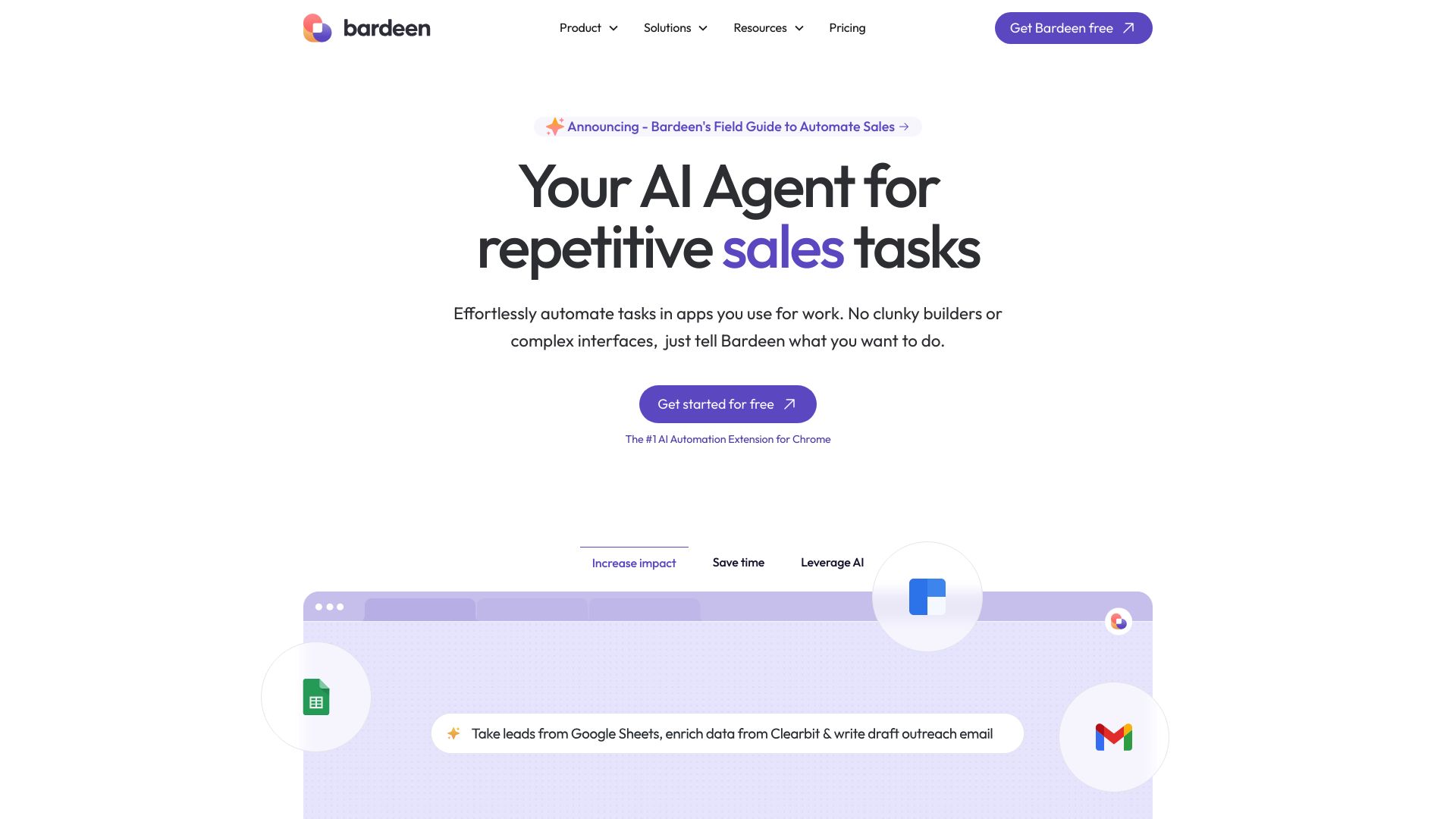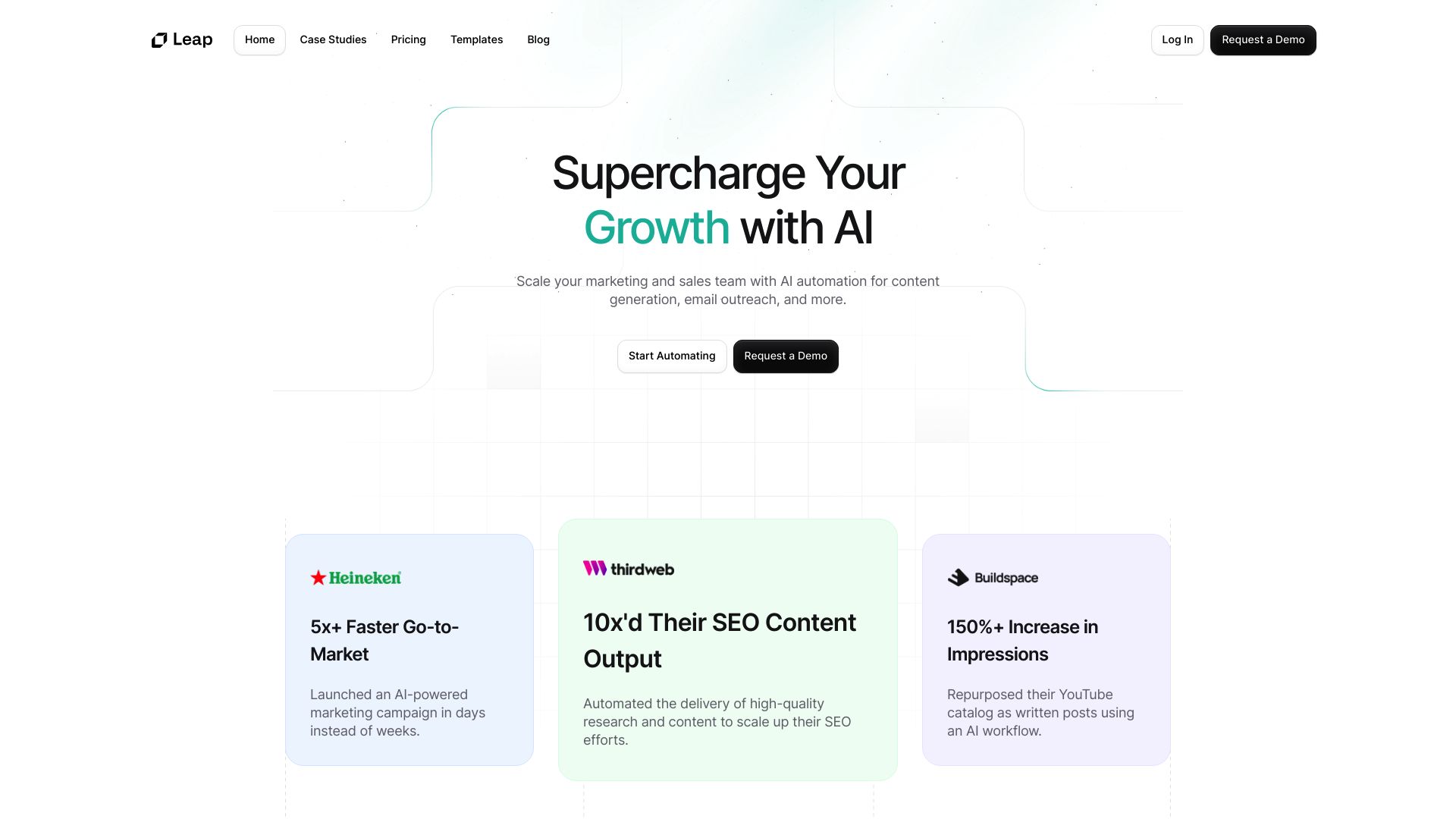Bardeen AI vs. Leap AI: Comparing Workflow Automation Platforms
AI-powered automation tools are transforming how businesses streamline workflows and boost productivity. We will compare Bardeen AI vs. Leap AI and explore Bardeen AI’s browser-based automation platform and Leap AI’s comprehensive workflow creation environment. We’ll examine how these tools empower users to build custom AI solutions, highlighting key features, integration capabilities, and deployment options.
By understanding the strengths and limitations of each platform, readers can make informed decisions about which tool best suits their automation needs. We’ll also introduce SmythOS, a versatile AI development platform that combines intuitive design with powerful enterprise-grade capabilities, offering a compelling alternative for those seeking advanced AI solutions.
Bardeen AI Overview
Bardeen AI offers a no-code web automation platform that empowers users to streamline repetitive tasks through a Chrome browser extension. The platform’s visual workflow builder allows users to create custom automations, called Playbooks, without coding expertise.
Bardeen AI caters to professionals seeking to enhance productivity by automating routine web-based activities. Its drag-and-drop interface enables users to construct workflows using pre-built actions and triggers for popular applications like Gmail, Google Sheets, and LinkedIn. The platform incorporates AI-powered features, including text classification, data extraction, and text generation, leveraging models such as GPT-3 to augment automation capabilities.
Bardeen AI offers a no-code web automation platform that empowers users to streamline repetitive tasks through a Chrome browser extension.


A key strength of Bardeen AI lies in its human-in-the-loop interaction model. Users can actively participate in guiding automations, validating data, and providing inputs when necessary. This approach allows for personalized automation tailored to specific needs, rather than a one-size-fits-all solution.
A key strength of Bardeen AI lies in its human-in-the-loop interaction model… allowing for personalized automation tailored to specific needs.
While Bardeen AI excels in browser-based automation and AI-assisted workflows, it has limitations. The platform lacks capabilities for independent agents, extensive scalability, and advanced deployment options. It does not offer features like memory persistence, multi-agent collaboration, or constrained alignment.
Additionally, Bardeen AI’s focus on browser-based robotic process automation (RPA) with human oversight makes it less suitable for fully autonomous, hands-off automation scenarios.
Bardeen AI’s vision centers on democratizing automation by enabling users to build workflows for their repetitive tasks without extensive coding knowledge. The platform aims to evolve automation from pure efficiency to augmenting human capabilities through AI participation. This approach positions Bardeen AI as a tool for users who seek to enhance their productivity through guided, personalized automations rather than those requiring complex, enterprise-wide orchestration or fully autonomous agents.
Bardeen AI’s vision centers on democratizing automation by enabling users to build workflows for their repetitive tasks without extensive coding knowledge.
Leap AI Overview
Leap AI empowers users to create sophisticated AI workflows without coding expertise. The platform’s no-code visual interface allows rapid development of AI-powered applications for tasks ranging from content generation to data analysis.


Leap AI’s comprehensive SDK support, including RESTful API, TypeScript, and Python options, facilitates seamless integration into existing systems. The platform boasts an extensive template library, enabling users to jumpstart projects with pre-built solutions for blog post creation, music generation, and lead summarization.
Leap AI empowers users to create sophisticated AI workflows without coding expertise. The platform’s no-code visual interface allows rapid development of AI-powered applications…
The software supports a diverse array of AI models, including OpenAI GPT, Mistral 7b, Claude 3 Opus, and Stable Diffusion XL. This versatility allows users to tackle a wide range of tasks, from text generation to image creation. Leap AI’s integration capabilities extend to popular tools like Slack, HubSpot, Zendesk, and Zapier, enhancing its utility across various business processes.
While Leap AI offers powerful features, users should consider potential limitations. The platform’s focus on template-based solutions may restrict highly customized implementations. Additionally, the learning curve for leveraging advanced features might be steep for some users, despite the no-code interface. As with any cloud-based solution, users must also carefully consider data privacy and security implications when handling sensitive information through the platform.
Feature Comparison
Bardeen AI and Leap AI offer contrasting approaches to AI-powered automation and workflow creation. Bardeen AI focuses on browser-based automation through a Chrome extension, emphasizing human-in-the-loop interactions and personalized workflows. In contrast, Leap AI provides a more comprehensive platform for creating AI-powered applications with broader deployment options.
Core component differences highlight Leap AI’s advantage in offering a wider range of AI model integrations, including OpenAI GPT, Mistral 7b, and Claude 3 Opus. Bardeen AI primarily relies on models like GPT-3 for its AI capabilities. Leap AI also boasts stronger multimodal support, handling tasks from text generation to image creation, while Bardeen AI’s capabilities are more limited to text-based interactions and web scraping.
Regarding security, both platforms emphasize data protection, but Leap AI’s broader integration capabilities may present more complex security considerations. Bardeen AI’s browser-based approach offers a more contained environment, potentially simplifying some security aspects. However, Leap AI’s support for diverse deployment options, including API and webhook implementations, provides greater flexibility for enterprise-level security configurations.
| Bardeen AI | Leap AI | SmythOS | |
|---|---|---|---|
| CORE FEATURES | |||
| Hosted Agents (Dev, Production) | ✅ | ❌ | ✅ |
| Memory & Context | ❌ | ✅ | ✅ |
| Autonomous Agents | ❌ | ❌ | ✅ |
| Explainability & Transparency | ✅ | ❌ | ✅ |
| Debug Tools | ❌ | ❌ | ✅ |
| Multimodal | ❌ | ✅ | ✅ |
| Problem-Solving Capabilities | ❌ | ✅ | ✅ |
| Multi-Agent Collaboration | ❌ | ❌ | ✅ |
| Audit Logs for Analytics | ❌ | ✅ | ✅ |
| Work as Team | ✅ | ✅ | ✅ |
| Logs & Monitoring | ✅ | ✅ | ✅ |
| SECURITY | |||
| Constrained Alignment | ❌ | ❌ | ✅ |
| Data Encryption | ✅ | ✅ | ✅ |
| IP Control | ❌ | ✅ | ✅ |
| COMPONENTS | |||
| Foundation AIs | ❌ | ✅ | ✅ |
| Huggingface AIs | ❌ | ✅ | ✅ |
| Zapier APIs | ❌ | ✅ | ✅ |
| Logic | ❌ | ✅ | ✅ |
| Data Lakes | ❌ | ❌ | ✅ |
| DEPLOYMENT OPTIONS (EMBODIMENTS) | |||
| Deploy as API | ❌ | ✅ | ✅ |
| Deploy as Webhook | ❌ | ✅ | ✅ |
| Staging Domains | ❌ | ✅ | ✅ |
| Production Domains | ❌ | ✅ | ✅ |
| API Authentication (OAuth + Key) | ❌ | ✅ | ✅ |
| Deploy as Site Chat | ❌ | ❌ | ✅ |
| Deploy as Scheduled Agent | ✅ | ✅ | ✅ |
| Deploy as GPT | ❌ | ✅ | ✅ |
| DATA LAKE SUPPORT | |||
| Hosted Vector Database | ❌ | ❌ | ✅ |
| Sitemap Crawler | ❌ | ✅ | ✅ |
| YouTube Transcript Crawler | ✅ | ❌ | ✅ |
| URL Crawler | ❌ | ✅ | ✅ |
| PDF Support | ✅ | ✅ | ✅ |
| Word File Support | ❌ | ✅ | ✅ |
| TXT File Support | ❌ | ✅ | ✅ |
Best Alternative to Bardeen AI and Leap AI
SmythOS emerges as the superior alternative to Bardeen AI and Leap AI, offering a comprehensive agentic AI automation platform that surpasses its competitors in key areas. Our platform combines ease of use with an extensive feature set, enabling users to create and deploy AI agents for unlimited use cases.
We provide a visual builder and no-code options, making AI development accessible to users of all skill levels. Unlike Bardeen AI’s browser-based approach or Leap AI’s limited deployment options, SmythOS offers versatile deployment choices including APIs, webhooks, scheduled agents, and site chat integration.
SmythOS offers versatile deployment choices including APIs, webhooks, scheduled agents, and site chat integration.
Our platform excels in areas where Bardeen AI and Leap AI fall short. We support autonomous agents with memory and context capabilities, enabling more sophisticated and context-aware AI interactions. Multi-agent collaboration, a feature absent in both Bardeen AI and Leap AI, allows for complex task solving and teamwork among AI agents.
SmythOS stands out with its robust security features, including constrained alignment and IP control, ensuring your AI solutions remain secure and compliant. We also offer a wider range of integrations, supporting various AI models, APIs, and data sources, giving you unparalleled flexibility in building your AI workflows.
SmythOS stands out with its robust security features, including constrained alignment and IP control, ensuring your AI solutions remain secure and compliant.
By choosing SmythOS, you’re not just selecting a tool; you’re empowering your organization with a scalable, secure, and feature-rich AI platform that adapts to your evolving needs. Experience the future of AI automation with SmythOS — where innovation meets simplicity.
Conclusion
Bardeen AI and Leap AI offer unique approaches to AI-powered automation, each with its strengths and limitations. Bardeen AI excels in browser-based automation with its Chrome extension, enabling users to create personalized workflows for web tasks. Leap AI provides a more comprehensive platform for building AI applications, supporting a wider range of AI models and deployment options.
While both platforms have their merits, SmythOS emerges as the superior choice for those seeking a truly versatile and powerful AI development environment. Our platform combines the best of both worlds, offering an intuitive visual builder for easy workflow creation and the robust capabilities needed for complex, enterprise-grade AI solutions.
SmythOS stands out with its extensive feature set, including multi-agent collaboration, versatile deployment options, and support for a wide array of AI models and integrations. We provide unparalleled flexibility, allowing you to create and deploy AI agents as APIs, chatbots, scheduled tasks, or even GPT models. Our platform’s scalability, security features, and data lake support make it ideal for businesses of all sizes, from startups to large enterprises.
To experience the full potential of AI development and automation, create a free SmythOS account today. Discover how our platform can transform your workflow, boost productivity, and drive innovation in your organization. For those looking to dive deeper, explore our comprehensive documentation or browse our extensive library of agent templates to jumpstart your AI journey with SmythOS.
Last updated:
Disclaimer: The information presented in this article is for general informational purposes only and is provided as is. While we strive to keep the content up-to-date and accurate, we make no representations or warranties of any kind, express or implied, about the completeness, accuracy, reliability, suitability, or availability of the information contained in this article.
Any reliance you place on such information is strictly at your own risk. We reserve the right to make additions, deletions, or modifications to the contents of this article at any time without prior notice.
In no event will we be liable for any loss or damage including without limitation, indirect or consequential loss or damage, or any loss or damage whatsoever arising from loss of data, profits, or any other loss not specified herein arising out of, or in connection with, the use of this article.
Despite our best efforts, this article may contain oversights, errors, or omissions. If you notice any inaccuracies or have concerns about the content, please report them through our content feedback form. Your input helps us maintain the quality and reliability of our information.
